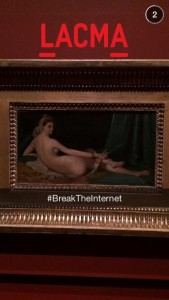
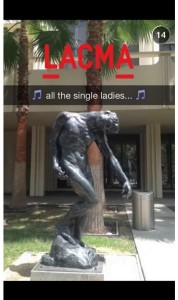
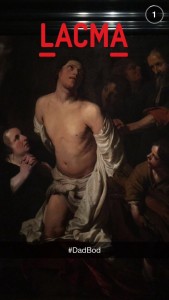
By almost all accounts, the Los Angeles County Museum of Art’s (LACMA’s) 2014 leap into the then-new, ephemeral social media platform of Snapshot was a total slam dunk. Often hilarious and always hip, their memes followed a simple format: LACMA in red at the top and a full-screen photo of one of their pieces of art, overlaid with a simple strip of text that drew a connection between the artwork and a pop-culture sound bite. Rodin poses that echo Beyonce’s dance moves, classical paintings that evoke an Iggy Azalea-esque attitude, and artwork that seems to quote “Mean Girls,” LACMA’s social media manager Maritza Yoes created pairings that were both irreverent and brilliant at once and, in the process, created a buzz in the art world. Publications lauded the success of this thinly veiled marketing campaign with headlines such as, “You Need To Add This Art Museum On Snapchat Right Now!” (Buzzfeed), “LACMA Is Killing It On Snapchat” (LA List), “LACMA Snapchat Wins at Social Media” (ReDesign Report), and many many more equally hyperbolic titles of praise.
To my memory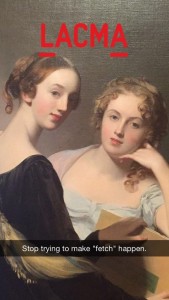 , never has a traditional art museum managed to pull off something so downright, utterly, and entirely cool.
, never has a traditional art museum managed to pull off something so downright, utterly, and entirely cool.
Seems like a win / win: LACMA proves it has 21st century cultural currency and the public’s laughter brings people right through LACMA’s front door as the museum experiences a rise in attendance. Museum gets hip, people go to museum. Art world saved. #micdrop. That’s the whole story . . . amirite?
Not completely.
What interests me, and should interest all of us who are involved in both communications and art experiences such as museums, theaters, and the like is a subtext that runs subtly in many of the articles written about the LACMA Snapchat phenomenon. In not all, but some, of the coverage, questions such as the following were asked about the campaign:
“Did it devalue the original intention of the art works?” (Larouci, 2015).
“Is it innovative or another example of the dumbing down of culture?” (Jinman, 2015).
These questions are great ones to ask. And, certainly, this line of thinking is not new or 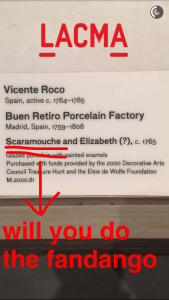 surprising. It springs from the age-old “high art” vs. “low art” debate, and I’ll leave it to you to decide where your opinions lie on the validity of this categorization. But, whether you believe that some art is sacred and pristine and other art is not, or you believe in the democratization and de-snobbifying of all artistic accomplishments, I think that it’s time that those of us who are in the business of marketing things we may consider to be “pure” acknowledged a central truth: our “pure” thing won’t continue to exist if people don’t participate in it.
surprising. It springs from the age-old “high art” vs. “low art” debate, and I’ll leave it to you to decide where your opinions lie on the validity of this categorization. But, whether you believe that some art is sacred and pristine and other art is not, or you believe in the democratization and de-snobbifying of all artistic accomplishments, I think that it’s time that those of us who are in the business of marketing things we may consider to be “pure” acknowledged a central truth: our “pure” thing won’t continue to exist if people don’t participate in it.
As they say in the theater business: we need butts in the seats to have a show on the stage.
Art marketers, education marketers, and socially or environmentally driven cause marketers are frequently accused of “selling out” or cheapening” the product that they seek to promote. And, for sure, there certainly is value to being on the lookout for the type of packaging of art that reduces it to nothing but a cheap commodity. But, where do we draw the line?
LACMA’s social media manager decided to answer this question as such:
“My intention was to democratize the experience and make it accessible, showing
the creativity of the museum, rather than try to emulate the museum experience . . . You have to communicate in the voice of the Internet for sure, and also have to carry the weight of a very famous institution” (Larouci, 2015). And, “Not only is Snapchat a great way to reach a younger audience, but it also provides us with a platform for play — a place where we can create stories and experiences around the museum, our collection, and our staff” (“Arty Snaps,” 2014).
T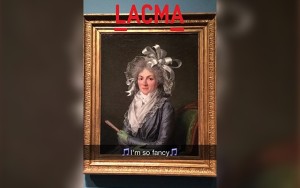 o me, such thoughtful responses reflect anything but a dumbing down of the art world and do not seem to
o me, such thoughtful responses reflect anything but a dumbing down of the art world and do not seem to
forebode museums’ death-by-Beyonce. What this sounds like is, rather, a celebration of art as a public, shared experience, a reminder that our revered museums have at least bit of room for our modern meme-loving, hash tagging moments of joy, and an example of a success story that can perhaps provide a moment of reprieve for the oft-maligned profession of marketing and communication. #wesellgoodstufftoo
References:
Arty Snaps (2014). Contagious. Retrieved from http://www.contagious.com/blogs/news-and-views/15274981-arty-snaps
Jinman, R. (2015, July 18). A Los Angeles art museum is turning classic works into memes and sharing them on Snapchat for youngsters to view. Independent. Retrieved from http://www.independent.co.uk/arts-entertainment/art/news/a-los-angeles-art-museum-is-turning-classic-works-into-memes-and-sharing-them-on-snapchat-for-10399282.html
Larouci, S. (2015, September 11). Art History’s meme queen connects Monet with Nicki Minaj. Amuse. Retrieved from https://amuse-i-d.vice.com/lacma-snapchat/
Probus, J. (2014, August 21). You need to add this art museum on Snapchat right now. Buzzfeed. Retrieved from http://www.buzzfeed.com/jessicaprobus/this-museum-is-better-at-snapchat-than-you#.srMQVbO89K
Tabasi, S. (2014, August 22). This museum wins at social media. Redesign Report. Retrieved from http://redesignreport.com/lacma-snapchat/
Trinh, J. (2014, August 22). LACMA is killing it on Snapchat. LA List. Retrieved from http://laist.com/2014/08/22/lacma_is_killing_it_on_their_snapch.php

6 Responses to Breaking the Internet at LACMA: When Pop Culture and “High” Culture Collide